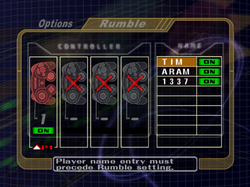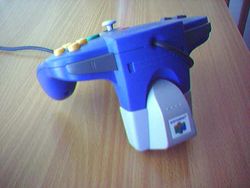Rumble: Difference between revisions
Queen Junko (talk | contribs) No edit summary |
Queen Junko (talk | contribs) (Better tag.) |
||
| Line 1: | Line 1: | ||
{{ArticleIcons|ssb=y|ssbm=y|ssbb=y|ssb4-wiiu=y}} | {{ArticleIcons|ssb=y|ssbm=y|ssbb=y|ssb4-wiiu=y}} | ||
{{ | {{image|Requires ''Smash 4'' information}} | ||
[[File:RumbleMelee.png|thumb|The Rumble menu in ''Super Smash Bros. Melee''|250px]] | [[File:RumbleMelee.png|thumb|The Rumble menu in ''Super Smash Bros. Melee''|250px]] | ||
'''Rumble''' can refer to either a function found in the various [[controller]]s available for the ''{{b|Super Smash Bros.|series}}'' series or to a menu found in ''[[Super Smash Bros. Melee]]'', ''[[Super Smash Bros. Brawl]]'', and ''[[Super Smash Bros. for Wii U]]''. | '''Rumble''' can refer to either a function found in the various [[controller]]s available for the ''{{b|Super Smash Bros.|series}}'' series or to a menu found in ''[[Super Smash Bros. Melee]]'', ''[[Super Smash Bros. Brawl]]'', and ''[[Super Smash Bros. for Wii U]]''. | ||
Revision as of 21:51, June 7, 2017
Rumble can refer to either a function found in the various controllers available for the Super Smash Bros. series or to a menu found in Super Smash Bros. Melee, Super Smash Bros. Brawl, and Super Smash Bros. for Wii U.
Controller function
The idea of adding vibration feedback to controllers was first introduced by the Nintendo 64 console in 1997, following the release of Star Fox 64. The peripheral, called the "Rumble Pak", connected to the expansion port built into the Nintendo 64 controllers and used a motor coupled with an unbalanced weight to enact its effects; whenever the motor spun its axle, the weight would cause rapid shifts in inertia in the controller, leading to the vibrating mechanism.
Initially expected to be a novelty, the "Rumble Pak" later spread, with many games later supporting the accessory, and some older games were actually re-released in order to take advantage of the peripheral. Among the games to feature Rumble Pak compatibility was Super Smash Bros.; the game would make the controllers rumble whenever the player's character was hit or performing an attack, amongst other events.
The later GameCube, Wii, and Wii U consoles all had controllers that would vibrate, but in these cases, the mechanism was built into the controller, as opposed to the Nintendo 64. The Classic Controller and Nunchuk, however, lack rumble mechanisms, though the Wii Remote they are connected to will still vibrate. In later games of the series, the controller began to rumble more often, such as before the Results screen and before starting matches in the Classic Mode.
Menu setting
Melee, Brawl, and Smash 4 have a "Rumble" settings in the Options menu, where the player can select whether or not they want their controllers to vibrate or not. Individual names also can have Rumble features on or off; in these cases, selecting the name overrides what the player's controller port is set to.
As the Rumble Pak can simply be removed from the Nintendo 64 controller, there is no Rumble menu in the original game.
In tournament play
While Rumble is enabled by default in the games, players in tournaments can choose whether or not to enable the feature on their controllers. Some players disable Rumble, as they find the effect to be distracting, and some controller mods even focus on removing the rumble motor from controllers as to prevent the need to manually disable the feature before matches. Other players leave Rumble on, as it can potentially act as a stimulus for Smash DI, or simply because they do not find the feature distracting.
Gallery
Trivia
- In Super Smash Bros. Melee, when the word "GAME!" appears after finishing a battle with the Master Hand glitch, the controller will vibrate constantly until the game is reset. This is because the controller vibrates until the character appears in his or her victory pose on the results screen, but as Master Hand does not have a victory pose, the controller will not stop vibrating.
| Super Smash Bros. Melee menu items | |
|---|---|
| Vs. Mode | Melee (Time · Stock · Coin Battle · Bonus · Team Battle) · Custom Rules · Special Melee · Tournament Mode · Names |
| 1-P Mode | Regular Match (Classic Mode · All-Star Mode · Adventure Mode) · Event Match · Stadium (Target Test · Home-Run Contest · Multi-Man Melee) · Training |
| Trophies | Gallery · Collection · Lottery |
| Options | Rumble · Sound · Screen Display · Language · Erase Data |
| Data | Snapshots · Melee Records · Sound Test · Archives (NTSC only) · How to Play (PAL only) |
| Unused | Debug menu · Debug sound test menu |
| Super Smash Bros. Brawl menu items | |
|---|---|
| Group | Brawl (Time · Stock · Coin Battle · Team Battle) · Rules · Special Brawl · Rotation · Tourney · Names |
| Solo | Classic · All-Star · Adventure Mode: The Subspace Emissary · Events · Stadium (Target Smash!! · Home-Run Contest · Multi-Man Brawl · Boss Battles) · Training |
| Wi-Fi | Spectator Mode · With Anyone · With Friends |
| Vault | Trophies & Stickers (Trophy Gallery · Trophy Hoard · Coin Launcher · Sticker Album · Sticker Center) · Stage Builder · Album · Challenges · Replays · Masterpieces · Chronicle |
| Options | Screen · Deflicker · Rumble · Controls · Sound · My Music · Erase Data |
| Data | Movies · Records (Group Records · Brawl Records · Notices) · Sound Test |



